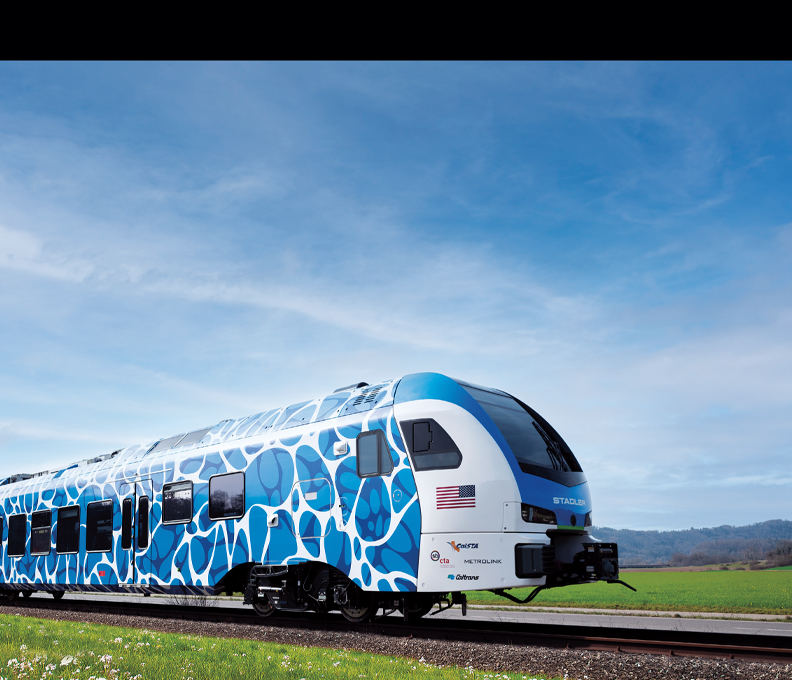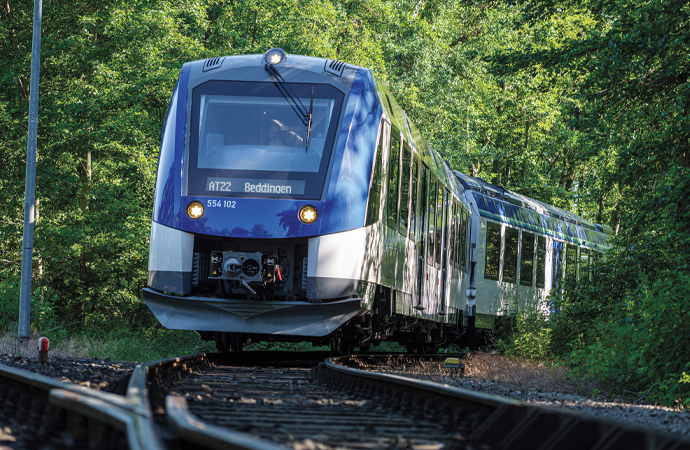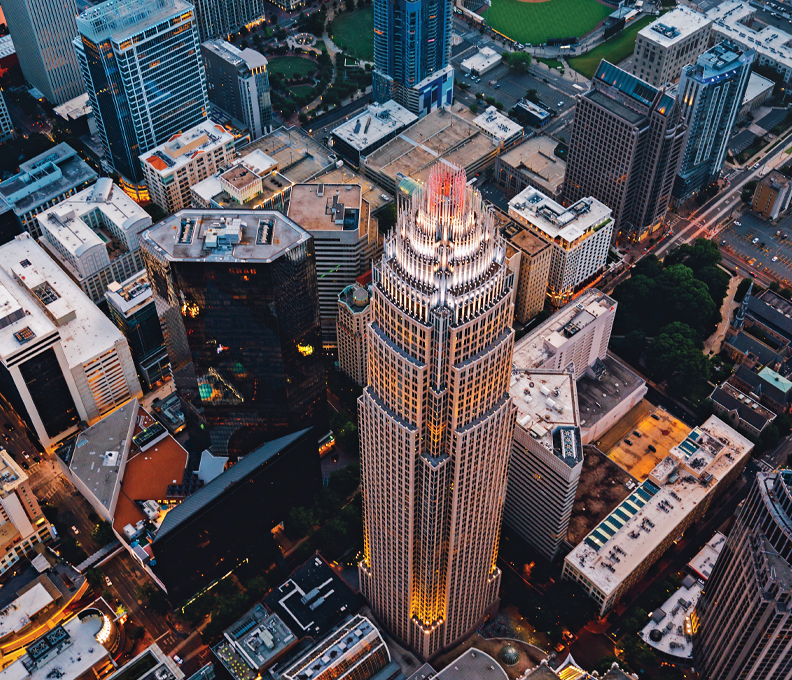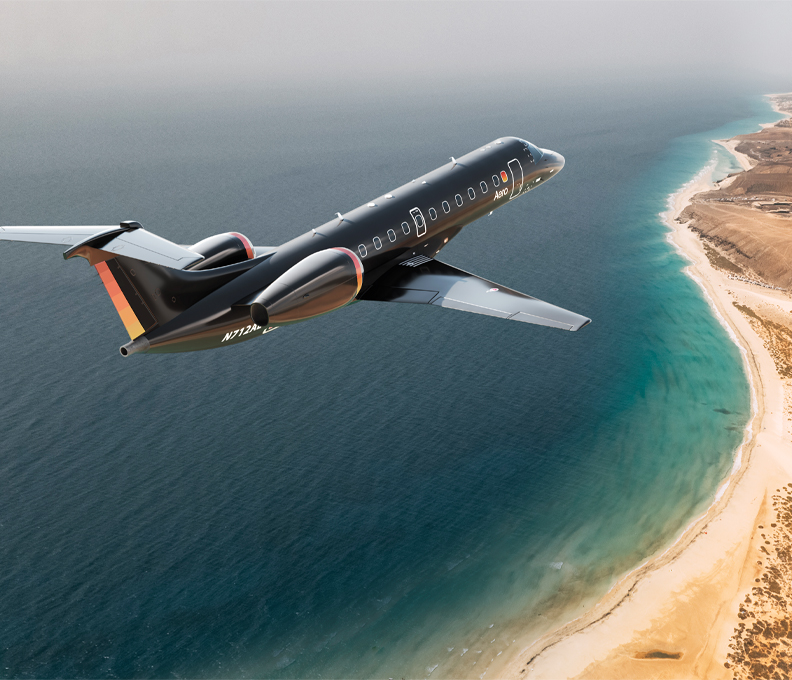Could Hydrogen-Powered Trains Come to American Railroads?
The passenger vehicles are increasingly seen as a way to slash carbon emissions and other pollutants in the transport sector
by Boyd Farrow
October 16, 2023

Stadler’s FLIRT train / Photo: Courtesy of Stadler
It is likely some San Bernardino residents will think they’re hallucinating when they see what looks like a very long swimming pool hurtling past their yards next year. The county’s transit authorities are so keen to make a splash with their newly purchased hydrogen-powered passenger trains they have opted to keep the sun-dappled water pattern used by Swiss manufacturer Stadler to camouflage the prototype prelaunch.
California has agreed to buy four of Stadler’s eco-friendly FLIRT trains with an option for another 25, which would replace the polluting diesel locomotives used by Amtrak regional routes. They are a crucial component of the state’s aim to have 100 percent emissions-free passenger rail by 2035.
Hydrogen-powered trains are increasingly seen as a way to slash carbon emissions and other pollutants in the transport sector. The hydrogen isn’t used directly for propulsion, like when a rocket is thrust into space. Rather, fuel cells convert tanks of hydrogen gas into electricity that flows to a traction battery. The electricity then powers the drive system and stores energy for braking.
According to Stefan Bernsdorf, senior project manager at Stadler, the sleek and almost silent 108-seater FLIRT can travel for approximately 500 miles without refueling. It can reach 79 mph and operate in temperatures of up to 120 degrees Fahrenheit. In the Golden State, nearly a third of the electricity produced will be needed just to power the air-conditioning.
“This type of technology could have a big impact on rail travel in America, where, because of the huge distance between cities, less than one percent of the railway system is electrified,” says Bernsdorf. “By comparison, in Switzerland, it is 99 percent.
“Of course, Switzerland doesn’t have two-mile-long trains or mudslides, so we have to adjust our engines for every different environment,” he adds. “Hydrogen won’t be a solution for all of America’s railway systems, but because of the country’s size, the potential is still considerable.”
While the first FLIRT—set to debut next summer in the San Bernardino city of Redlands—recently left Europe by sea, future trains will be produced at Stadler’s recently opened facility in Salt Lake City. Bernsdorf notes the Western U.S. state is investing heavily in electric battery assembly.

Alstom’s Coradia iLint train / Photo: Courtesy of Alstom
However, Stadler is not the only European rolling-stock giant bringing cutting-edge hydrogen technology across the Atlantic. In 2022 France’s Alstom opened an innovation hub at its Americas headquarters in St-Bruno-de-Montarville, Quebec, to develop future platforms for green hybrid, battery or hydrogen propulsion technologies specifically for the North American rail freight and passenger market. Since June, Alstom has been trialing its hydrogen-powered Coradia iLint train on the 56-mile track alongside the St. Lawrence River between Parc de la Chute-Montmorency in Quebec City and Baie-Saint-Paul, in the heart of the Charlevoix Biosphere Reserve.
The iLint became the world’s first hydrogen-powered passenger train in commercial service in 2022, when it began operating in Bremervörde, a sleepy scenic town in northwestern Germany. Since then, Alstom has racked up orders for more than 40 trains from countries throughout Europe.
Although the iLint has traveled a distance of 730 miles without refueling, its inaugural route brought about the creation of the world’s first filling station for passenger trains. The facility at Bremervörde has a capacity of 1.75 tons of hydrogen, enabling 14 trains to be refueled daily.
Naturally, implementing the infrastructure for production, transportation and management of refueling stations across the U.S. presents a much greater challenge. Indeed, Éric Rondeau, who heads the Quebec innovation hub, says that the trials in Canada will help determine the next phase of Alstom’s planned expansion.
“The Quebec project has led to an ecosystem, which includes an innovative mobile refueling station and various storage capacities,” says Rondeau. “This will be used as a benchmark for the next regional deployment in the corridors ready to adopt hydrogen infrastructure.”
He is optimistic that the U.S.’ $8 billion Hydrogen Hubs program and the $369 billion earmarked for green infrastructure by the Inflation Reduction Act will help accelerate the rollout of hydrogen-powered trains throughout America during the next 10 to 15 years. According to Rondeau, “Not only will hydrogen fueling stations become more common as the technology is more widely adopted, but we also expect hydrogen fuel-cell technology to continue to advance in tandem with market demand.”
The current whirl of technological advances in this area pairs nicely with U.S. lawmakers’ newfound interest in passenger rail in the face of environmental concerns and worsening road congestion. President Biden’s $1.2 trillion infrastructure bill includes an unprecedented $170 billion to improve the nation’s long neglected railroads. Currently there are plans to bring rail travel back to some cities and regions that have not seen a passenger train for decades—let alone one that resembles a moving David Hockney painting.



